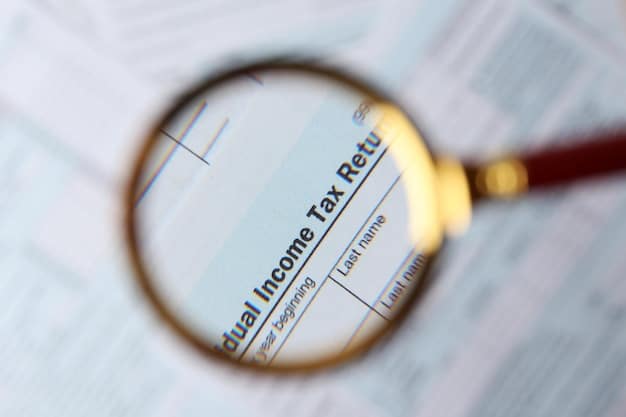New IRS Rules for 2025: Understanding Estimated Taxes

New IRS rules for 2025 concerning estimated taxes introduce significant changes for self-employed individuals, gig workers, and those with substantial non-wage income, emphasizing the need for proactive tax planning and accurate quarterly payments to avoid penalties.
Navigating the complexities of the tax system can be daunting, especially when new regulations come into play. The **New IRS Rules for 2025: What You Need to Know About Estimated Taxes** are crucial for understanding your obligations and avoiding potential penalties. This guide will help you stay informed and compliant.
Understanding Estimated Taxes: A Primer
Estimated taxes are a method of paying income tax and self-employment tax, as well as other taxes, that are not withheld from your paycheck. This is particularly relevant if you are self-employed, a small business owner, or have significant income from sources other than wages.
Who Needs to Pay Estimated Taxes?
Generally, you need to pay estimated taxes if you expect to owe at least $1,000 in tax for the year, after subtracting your withholding and refundable credits. This applies to individuals, corporations, and partnerships.
When Are Estimated Taxes Due?
Estimated taxes are typically paid in four quarterly installments. These due dates are usually April 15, June 15, September 15, and January 15 of the following year. However, these dates may shift slightly depending on the calendar.
- Self-Employed Individuals: The main group required to pay estimated taxes.
- Gig Workers: Growing numbers in the gig economy also require estimated tax payment.
- Investors: Those with substantial investment income need attention here too.
In essence, understanding estimated taxes involves recognizing who is obligated to pay them, when these payments are due, and how to calculate the correct amount to avoid penalties or overpayment.
Key Changes in the IRS Rules for 2025
The IRS regularly updates its rules and regulations, and 2025 is no exception. Several key changes regarding estimated taxes are important for taxpayers to understand and prepare for. These changes may affect how much you owe and when you need to pay.

Increased Scrutiny on High-Income Earners
The IRS is increasing its scrutiny on high-income earners, which may mean stricter enforcement of estimated tax payments. This could result in higher penalties for those who underpay their taxes.
New Thresholds for Penalties
There may be adjustments to the thresholds that trigger penalties for underpayment of estimated taxes. Keeping abreast of these changes can help you avoid unexpected fines.
Staying informed about these evolving IRS rules is paramount for compliance. Understanding how these changes specifically apply to your financial situation can save you from potential discrepancies and penalties.
Calculating Your Estimated Tax Payments
Accurately calculating your estimated tax payments is critical to avoid underpayment penalties. The IRS provides several methods to help you determine the correct amount. Here’s a breakdown of the most common approaches:
The Prior Year Method
One of the simplest methods is to base your estimated tax payments on your prior year’s tax liability. If your income is relatively stable from year to year, this can be a reliable approach.
The Current Year Method
The current year method involves estimating your income, deductions, and credits for the current tax year. This method can be more accurate but requires careful forecasting.
- Use IRS Form 1040-ES: To calculate estimated tax for individuals.
- Consider All Income Sources: Include self-employment, investments, and other non-wage income.
- Factor in Deductions and Credits: Like itemized deductions or tax credits.
Ultimately, choosing the right calculation method depends on your unique financial situation and how prepared you are to forecast your annual income. Always double-check your calculations to ensure accuracy and avoid unnecessary penalties.
Strategies to Minimize Estimated Tax Penalties
Even with careful planning, unforeseen circumstances can make it challenging to accurately estimate your tax liability. However, there are strategies you can employ to minimize or avoid penalties for underpayment of estimated taxes:
Increase Withholding from Wages
If you have a job in addition to self-employment income, consider increasing the amount of tax withheld from your wages. This can help offset any underpayment of estimated taxes.
Make Timely Payments
Ensure you make your estimated tax payments on time. Even if you can’t pay the full amount, paying as much as possible by each due date can reduce potential penalties.

By taking proactive steps such as increasing your wage withholding, making timely payments, and utilizing the annualized income method, you can significantly reduce the risk of incurring estimated tax penalties. Staying on top of these strategies can save you money and stress in the long run.
Common Mistakes to Avoid with Estimated Taxes
When it comes to estimated taxes, there are several common pitfalls that taxpayers often encounter. Being aware of these mistakes can help you avoid unnecessary complications and penalties.
Underestimating Income
One of the most common mistakes is underestimating your income. Be sure to account for all sources of income, including self-employment earnings, investment income, and any other taxable income.
Forgetting Deductions and Credits
Another error is overlooking eligible deductions and credits. Make sure to factor in all applicable deductions, such as business expenses or qualified retirement contributions, as well as any tax credits you may be entitled to.
- Inaccurate Income Projection: Can lead to significant underpayment.
- Missed Quarterly Deadlines: Resulting in penalties.
- Neglecting to Update Estimates: Failing to adjust as income changes.
Avoiding these common mistakes requires due diligence, accurate record-keeping, and periodic reviews of your financial situation. Staying vigilant and informed can help you navigate estimated taxes with confidence.
Resources for Staying Compliant with IRS Tax Rules
Navigating the complexities of IRS tax rules can be challenging, but there are numerous resources available to help you stay compliant and informed. Utilizing these tools can provide clarity and confidence in managing your tax obligations.
IRS Website
The IRS website is a comprehensive source of information on all things tax-related. You can find forms, instructions, publications, and answers to frequently asked questions.
Tax Professionals
Consider seeking the assistance of a qualified tax professional, such as a certified public accountant (CPA) or a tax attorney. They can provide personalized guidance and help you navigate complex tax issues.
By leveraging these resources, such as the IRS website and professional tax advisors, you can equip yourself with the knowledge and support needed to navigate the complexities of IRS tax rules and maintain compliance.
| Key Point | Brief Description |
|---|---|
| 🗓️ Quarterly Deadlines | Payments due April, June, September, January. |
| 💼 Self-Employment | Primary group needing to pay estimated taxes. |
| 📈 Income Estimation | Accurate forecasting prevents underpayment penalties. |
| 💡 Penalties Minimization | Increase withholding or pay on time to reduce penalties. |
Frequently Asked Questions (FAQ)
Estimated taxes are primarily for those who don’t have taxes withheld from their income, such as self-employed individuals, gig workers, and those with significant investment income. Generally, if you expect to owe at least $1,000 in taxes, you’re required to pay estimated taxes.
Estimated taxes are typically paid in four quarterly installments. The due dates are usually April 15, June 15, September 15, and January 15 of the following year. Be mindful of these dates to avoid penalties.
If you underestimate your taxes and owe more than $1,000, you may be subject to penalties. It’s important to calculate your estimated tax liability accurately and make timely payments to minimize or avoid these penalties.
Yes, the IRS offers several convenient ways to pay estimated taxes online, including IRS Direct Pay, Electronic Federal Tax Payment System (EFTPS), and credit or debit card through an approved payment processor. These methods are secure and easy to use.
Comprehensive information on estimated taxes can be found on the IRS website. Additionally, consulting with a tax professional can provide personalized guidance and support to ensure you comply with all relevant tax rules.
Conclusion
Staying informed about the **New IRS Rules for 2025: What You Need to Know About Estimated Taxes** is crucial for anyone with income not subject to regular withholding. By understanding the changes, calculating your estimated tax payments accurately, and utilizing available resources, you can navigate your tax obligations effectively and avoid potential penalties. Always consult with a tax professional for tailored advice based on your specific financial circumstances.





